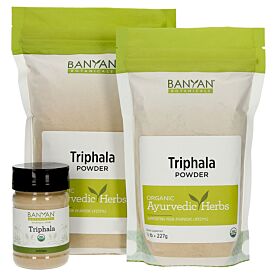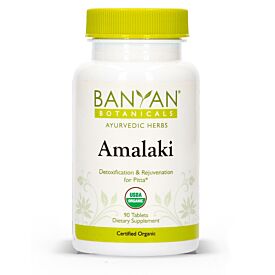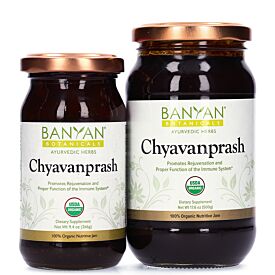Haritaki: Getting to Know Your Herbal Allies
Let us introduce you to haritaki (Terminalia chebula), one of the best allies in the Ayurvedic pharmacopoeia. Already heard of it? We’re not surprised, as it is one of the “Three Musketeers” of triphala powder, the most popular formula in Ayurveda. Beyond haritaki’s invaluable role in triphala, it is well worth our time to learn a little more about this particular “musketeer.” Haritaki is deeply revered among Ayurvedic herbs, and this respect is reflected in its many names—it is “the life giving,” “the animating,” “the unfailing,” “the restorative,” and “fearless against ill health.”1 It is even called “the divine fruit” and “the medicine that rejects all diseases.”2 Wow! This herb really is one for all (if you will please excuse the pun), bringing balance to all doshas, helping to cleanse the system, maintain regularity, and nourish and rejuvenate all the tissues—and so much more.
The Divine Fruit
Haritaki is a large tree that grows throughout the deciduous forests of Southern Asia and Sri Lanka. According to folklore, the first haritaki tree sprouted after a drop of amrit, the eternal nectar, dropped from the heavens upon the earth (well of course “the divine fruit” would have such an ethereal creation!).3 Ayurveda uses the small green fruits of the haritaki tree, and harvesting these is no small feat. It requires a skilled tree climber to shimmy up the tall trunk, sack in hand, and hand-pick each fruit.4
Another name for haritaki is hara, meaning green, which was undoubtedly inspired by those green fruits. As it happens, hara is also another name for Lord Shiva, and this is no coincidence. Connecting this tree to Lord Shiva, one of the principle deities of Hinduism, is a reverential way to acknowledge haritaki’s sacred nature.5
Haritaki’s exalted status is reinforced by its connection to the Medicine Buddha, who is often depicted holding haritaki fruit6 or a flowering branch of the haritaki tree.7 This placement speaks volumes to the veneration of haritaki by Tibetan healers. To some, this correlation goes even deeper, seeing the very presence of haritaki as a reflection of the Buddha’s nature, as one doctor has written: “Myrobalan (haritaki)[…]underlines the nature of the Buddha of Healing.”8 Knowing this correlation, it is not surprising to learn that haritaki plays a central role in Tibetan medicine, and in fact, haritaki is called “the king of medicine.” As “the king,” it is present in almost all Tibetan herbal formulas!9 This certainly isn’t out of convenience, as haritaki does not grow in Tibet and needs to be imported.10
| Haritaki and Anupanas | ||||
| To pacify vata | Take with ghee | |||
| To pacify pitta | Take with sugar | |||
| To pacify kapha | Take with rock salt | |||
Haritaki’s herbal prowess has not been limited to the circles of Eastern healing modalities.
It became so well-known that, in 1610, it even made a cameo in the play The Alchemist, written by the famous English playwright Ben Jonson. In this, a character describes a kiss as “So light, she melts/like Myrobalan.”11 (Myrobalan is the English name for haritaki.)

The King of Medicine
Taking a closer look at haritaki’s properties, it is easy to see why it is such a timeless favorite.
Haritaki is particularly famed for its ability to help pacify any vata imbalance. To emphasize the point, this truly is for any vata imbalance, especially those relating to the large intestine (incidentally, this is the “seat” or home of vata). This lends to haritaki’s ability to support healthy digestion, particularly for those who tend toward vata-type digestive imbalances, such as gas, bloating, variable appetite, and a wavering agni, or digestive fire (to learn more, check out this article on balancing vishama agni). Haritaki is also good for vata-type elimination imbalances.
While haritaki is so well known for its affinity for vata, haritaki is acutally tridoshic, meaning that it can help bring balance to all three doshas. We can partly make sense of this by looking at its rasa (taste). Haritaki contains five of the six tastes, all but salty. Thanks to the sweet, bitter, and astringent tastes, haritaki can help pacify excess pitta; with the presence of the astringent, bitter, and pungent tastes, it helps remove excess kapha; and with the sweet and sour tastes, it helps with excess vata.12 Beyond this, we don’t really know what makes haritaki tridoshic with such a knack for removing any excess dosha. This is one of haritaki’s prabhavas, or unique, inexplicable actions (and yes, haritaki has more than one prabhava!). And yet, somehow haritaki gracefully pulls it off.
Furthermore, haritaki reputedly increases prana, the super-fine essence of vata.13 Prana is the force that is present in every cell, in the subtle body, in the mind, and connected to our souls. It powers the body and keeps the mind supple and adaptable. It bestows creativity, enthusiasm, and strength. It is all this and more—and without prana, there is no life. This link to increasing prana could be behind the deep-rooted belief in India and Tibet that haritaki increases energy, intelligence, and awareness.14 These abilities could also support haritaki’s link to emotional health and its use when looking to alleviate grief and sadness.15 And perhaps this is even behind the claims that haritaki imparts strength and softens the effects of aging.16
Or perhaps these extraordinary actions could also be due to haritaki’s rasayana, or rejuvenative quality. This quality is very supportive to vata and the large intestine (there’s that seat of vata again). Its rejuvenation goes deeper—it penetrates all seven dhatus (tissue layers), providing delicious full-body strength and nourishment, and then goes on to support the proper function of the colon, lungs, liver, and spleen.17 And, as if that wasn’t enough, thanks to its effect in the deepest tissue layer, shukra dhatu (the reproductive tissue layer), it helps to enhance immunity.18
Interestingly, haritaki has a “scraping” action in the body, supporting the body in gentle cleansing and detoxification, which ultimately keeps systems running smoothly and can even help with maintaining healthy weight levels.19 How haritaki manages to be both cleansing and rejuvenating is a bit of an Ayurvedic paradox, but it is certainly one of the many reasons why haritaki is so effective.

Welcoming Haritaki into Your Daily Routine
Incorporating haritaki into your daily routine (dinacharya) is simple. It can be taken on its own, and it does famously well in formulas—as is evident with the popularity of triphala as well as haritaki’s presence in almost all Tibetan formulas. To tackle a specific dosha, take haritaki with a corresponding anupana (carrier)—use haritaki with rock salt to pacify kapha, with sugar (try an organic, raw, unprocessed sugar) to remove excess pitta, and with Ghee to bring down vata.20
Haritaki can be taken year-round, and if you’re looking to bring overall balance to your doshas, simply adjust the carrier as the seasons change. Ayurveda gives us some pointers for this:
“As a tonic for promoting and preventing the effects of age, chebulic myrobalan [haritaki] should be taken every morning with salt during the rainy season, with sugar in the autumn, with ginger in the first half of winter, with long pepper in the second half of winter, with honey in the spring, and with treacle in the hot months.”
And, of course, haritaki is in triphala. Everything that haritaki brings on its own to support health in the body-mind, it brings to triphala, and these actions are compounded by the other two “musketeers,” amalaki and bibhitaki. These three herbs work synergistically to support natural internal cleansing, support agni and the absorption of nutrients, and to bring deep nourishment and rejuvenation to the whole body. No wonder triphala is easily the most beloved formula in Ayurveda!
There are so many additional formulas that benefit from the presence of haritaki, let alone the addition of triphala. In our own formulas, you will find haritaki in everything from our Immune Strong to our Heart Formula, Joint Balm, Daily Swish, Chyavanprash—and the list goes on!
This Is Just the Beginning
This blog only gives a simple sketch of haritaki—this is by no means comprehensive. We would very much enjoy whiling away the rest of the day discussing the many other qualities, actions, and mysteries of this super fruit, but discussing an herb only goes so far—haritaki can teach you far better than we ever could. Try it for yourself and witness the abundant benefits unfold in your own body-mind. How will you incorporate “the king of medicine” into your life? What will “the divine fruit” teach you?







